英语教学法ClassroomManagement
- 格式:ppt
- 大小:492.00 KB
- 文档页数:26
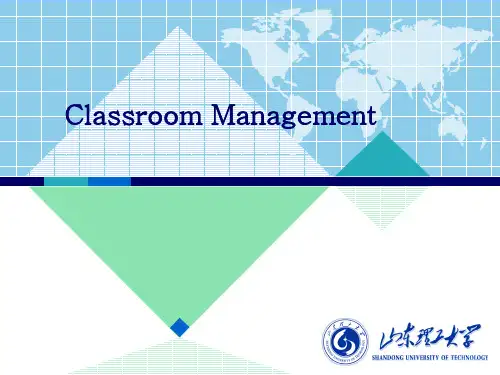
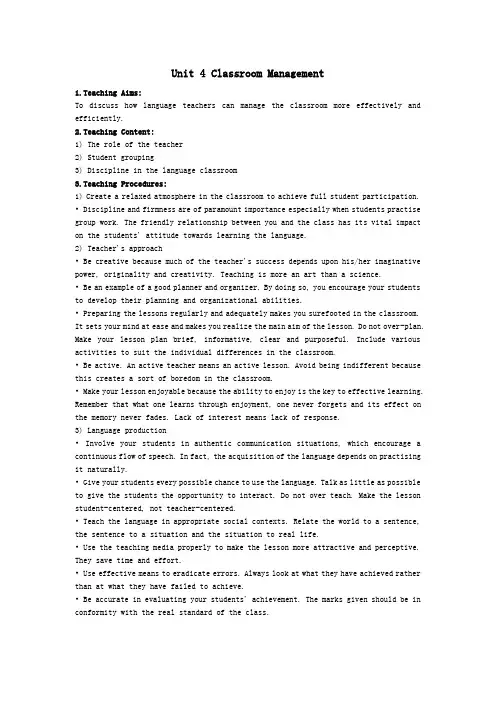
Unit 4 Classroom Management1.Teaching Aims:To discuss how language teachers can manage the classroom more effectively and efficiently.2.Teaching Content:1) The role of the teacher2) Student grouping3) Discipline in the language classroom3.Teaching Procedures:1) Create a relaxed atmosphere in the classroom to achieve full student participation. • Discipline and firmness are of paramount importance especially when students practise group work. The friendly relationship between you and the class has its vital impact on the students' attitude towards learning the language.2) Teacher's approach• Be creative because much of the teacher's success depends upon his/her imaginative power, originality and creativity. Teaching is more an art than a science.• Be an example of a good planner and organizer. By doing so, you encourage your students to develop their planning and organizational abilities.• Preparing the lessons regularly and adequately makes you surefooted in the classroom. It sets your mind at ease and makes you realize the main aim of the lesson. Do not over-plan. Make your lesson plan brief, informative, clear and purposeful. Include various activities to suit the individual differences in the classroom.• Be active. An active teacher means an active lesson. Avoid being indifferent because this creates a sort of boredom in the classroom.• Make your lesson enjoyable because the ability to enjoy is the key to effective learning. Remember that what one learns through enjoyment, one never forgets and its effect on the memory never fades. Lack of interest means lack of response.3) Language production•Involve your students in authentic communication situations, which encourage a continuous flow of speech. In fact, the acquisition of the language depends on practising it naturally.• Give your students every possible chance to use the language. Talk as little as possible to give the students the opportunity to interact. Do not over teach. Make the lesson student-centered, not teacher-centered.• Teach the language in appropriate social contexts. Relate the world to a sentence, the sentence to a situation and the situation to real life.• Use the teaching media properly to make the lesson more attractive and perceptive. They save time and effort.• Use effective means to eradicate errors. Always look at what they have achieved rather than at what they have failed to achieve.• Be accurate in evaluating your students' achievement. The marks given should be in conformity with the real standard of the class.。
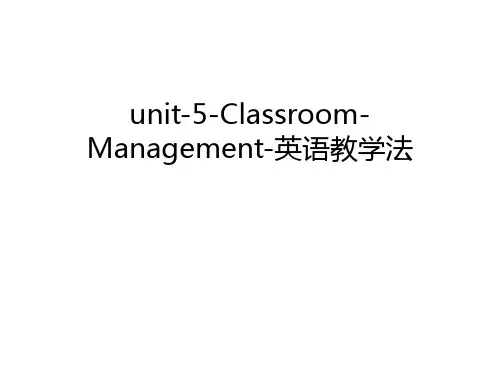

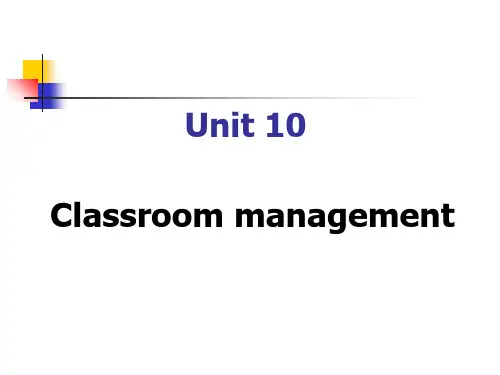
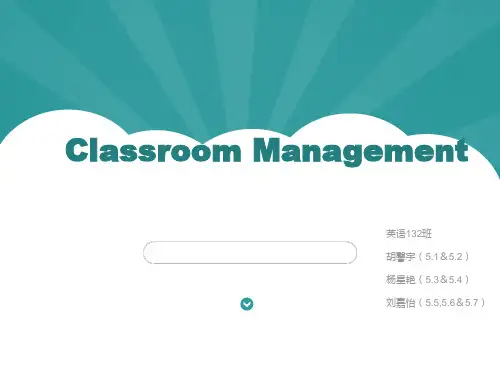

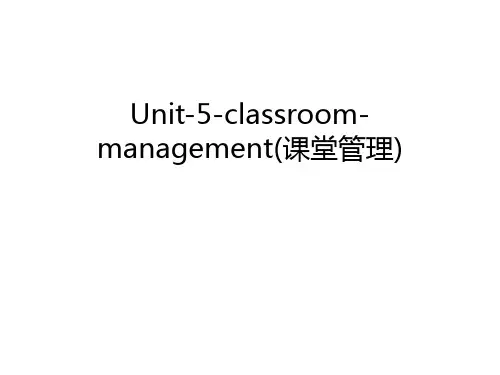
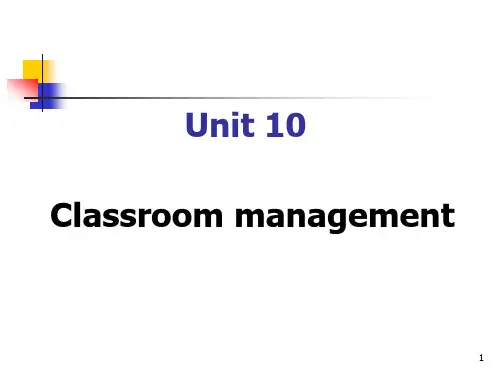
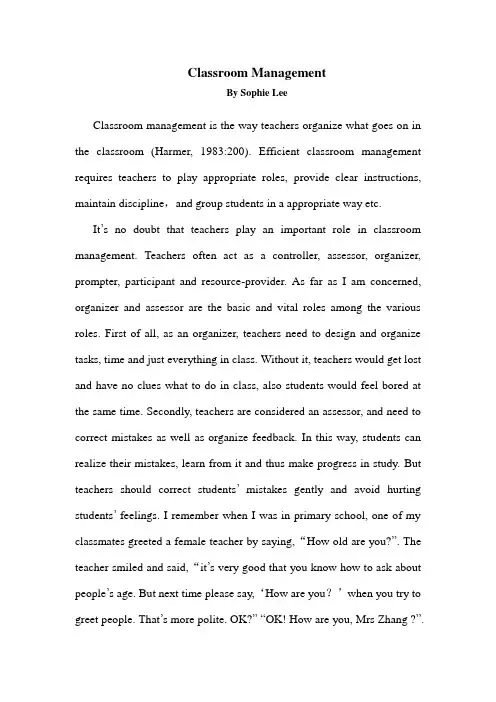
Classroom ManagementBy Sophie LeeClassroom management is the way teachers organize what goes on in the classroom (Harmer, 1983:200). Efficient classroom management requires teachers to play appropriate roles, provide clear instructions, maintain discipline,and group students in a appropriate way etc.It’s no doubt that teachers play an important role in classroom management. Teachers often act as a controller, assessor, organizer, prompter, participant and resource-provider. As far as I am concerned, organizer and assessor are the basic and vital roles among the various roles. First of all, as an organizer, teachers need to design and organize tasks, time and just everything in class. Without it, teachers would get lost and have no clues what to do in class, also students would feel bored at the same time. Secondly, teachers are considered an assessor, and need to correct mistakes as well as organize feedback. In this way, students can realize their mistakes, learn from it and thus make progress in study. But teachers should correct students’mistakes gently and avoid hurting students’ feelings. I remember when I was in primary school, one of my classmates greeted a female teacher by saying,“How old are you?”. The teacher smiled and said,“it’s very good that you know how to ask about people’s age. But next time please say,‘How are you?’when you try to greet people. That’s more polite. OK?”“OK! How are you, Mrs Zhang ?”.The student acted immediately and happily. I was impressed by the teacher’s gentle and effective words.Regarding to the different sizes, student grouping include whole class work, pair work, group work and individual study. I think they are equally important and suitable for different situations. To begin with, whole class work is a must in class, and teachers use it to present knowledge, so that students are given equal opportunities and time in the learning process. As students, we definitely feel involved in this way and would pay more attention to what the teacher is saying. What’s more, pair work ensures students to practice what have learned efficiently which benefit them enormously. Thirdly, group work is an excellent way for students to brainstorm ideas. We practice this a lot in class and it helps us become mare creative and active. Group work also enables us to use English to express our ideas clearly. Last but not least, individual study is also necessary to us. Especially after brainstorming in a group, we can write things down on our own.Speaking of the principals of classroom management, I think maintaining discipline is crucial to the effective learning in class. If teachers fail to maintain discipline, the class can be a mess, and none of the students would be able to learn anything efficiently. For instance, at the beginning of my middle school life, my class was often chaotic. Most teachers would act immediately and stopped the class until everyone wasin order again. That was really a headache for our head teacher, but she dealt with it nicely. She rearranged the seat and separated the troublesome students. Gradually, the discipline of our class became much better and students did a better job in study as well.Reference:1)Wang,Q.(2006).A Course of English Teaching. Beijing: Higher Education Press.。
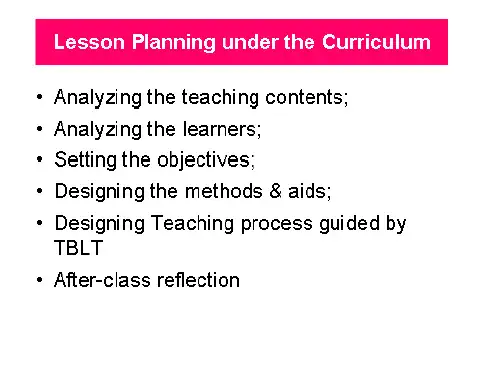
第5章Classroom management 理论知识多1. 课堂管理定义及goalClassroom management is the way teachers organize what goes on in the classroom.The goal of classroom management is to create an atmosphere conductive to interacting in English in meaningful ways.2. How to achieve effective classroom management?Effective classroom management can be achieved when the following six conditions are met:1) The teacher plays appropriate roles2) The teacher provides clear instructions.3) Suitable grouping of the students4) Discipline as well as harmony in the class.5) Asking appropriate questions.6) Treating students’ errors properly.第一部分教师角色一、The role of the teacher 教师角色2+6+3(1) Before the class—Planner 课前—设计者Before class, the teacher is a planner, who plans what to teach, how to teach, and what result to achieve. (2) During the class课中Based on the functions the teacher performs in different activities, Harmer defines the teacher’s roles as controller, assessor, prompter, participant, organizer, and resource-provider.①Controller 管理者An appropriate degree of control of the teacher over the class is vital in formal language teaching. The teacher controls the pace so that activities run smoothly and efficiently. For example, when students do skimming and scanning tasks, it is very important for teacher to control time.②Assessor评定者It is a major part of a teacher’s job to assess the students’ work. The teacher does two things: Correcting mistakes : The correcting should be gentle, not harsh.Organizing feedback: The feedback should be focused on students’ success or progress so that a success-oriented learning atmosphere can be created.③Prompter 促进者When students are not sure how to start an activity, or what to do next, or what to say next, the teacher should give appropriate prompts. The teacher should do:Giving hints (just like time, place…);Eliciting more (by saying “and…?” “Anything else?” Yes, but why…? )④Participant参与者Task-based teaching methods encourage the teacher to participate in students’ activities. Besides monitoring the class, the teacher can also join one or two groups as an ordinary participant. It is a good chance for students to practice English with a superior.⑤Organizer组织者One of the teacher’s major tasks is to design and organize tasks that students can perform in the class.⑥Resource-provider信息提供者The teacher is considered a good and convenient resource for the students. However, when students are supposed to work on their own, the teacher should withhold his readiness to provide resources.⑦Teacher’s new roles教师的新角色Teachers’ roles are not static. They change with the development of the society. The new curriculum requires the teacher to put on the following new roles: facilitator, guides, and researchers.1) Facilitators 辅助者:The teacher should function as a facilitator to students’ learning rather than simply transmitting knowledge. The teacher needs to create a positive learning environment, use various strategies to motivate learners, guide students in planning and assessing their learning and develop their learning strategies.2) Guides 指导者:During the process of education, teachers should position themselves as guides.The teacher needs to activate students’ prior knowledge; find their interests and explore potential capabilities; and evaluate their development fairly from an all-round perspective.3) Researchers 研究者:Good teachers are not only those with experience, but with rationalized thinking. Good teachers constantly reflect on what they do as a teacher and how their learners learn as learners.The teacher needs to make sense of what they do and how they affect learners; what their learners do and how learning is affected. Observe a problem, reflect on the reasons, think about possible solutions, implement the solutions and evaluate the results.(3) After the class—Evaluator课后—评估者After class the teacher is an evaluator, who evaluates not only how successfully he/she has conducted the class but also how efficient the learning activities have been.第二部分课堂指导一、课堂教学指导遵循的3个原则:Classroom instructions refer to the type of language teachers use to organize or guide learning. They include all classroom language that teachers may use for teaching purposes as well as for managing teaching.There are rules to follow for making instructions effective:The first rule is to use simple instructions and make them suit the comprehension level of the students. Make your own comments as simple and as natural as possible: “really?”, “Who is next?”The second rule is to use the mother-tongue only when it is necessary, and your lessons should be in the target language. Teachers can use body language to assist understanding.The third rule is that teachers should be careful not to do all the talking in class, and demonstration is usually more effective than words.第三部分分组一、The most common student groupings 最常见的学生分组4个①Whole class work refers to the time when all the students are under the control of the teacher. They are all doing the same activity at the same rhythm and pace. It happens when the teacher is presenting new language, giving explanation, checking answers, doing accuracy-based reproduction, or summarizing learning.②Pair work refers to the time when students work in pairs on an exercise or a task. It could be a dialogue reading, a game or an information-gap task between the two students.③Group work refers to the time when students work in small groups. Each group may have 3, 4, or 5 students, depending on the activity. Effective group work depends on careful preparation and meticulous management.④Individual study is the stage when students are expected to work on their own at their own speed.It involves activities such as silent reading, doing written exercises, writing something down individually after brainstorming in a group, or individual speech preparations.二、分组的优缺点第四部分纪律一、Discipline vs. indiscipline纪律和无纪律Discipline refers to a code of conduct which binds a teacher and a group of students together so that learning can be more effective. The ultimate goal of discipline is to make more effective learning possible. Indisciplined atmosphere will surely yield no learning at all. Indisciplined acts are not confined to students. Certain acts on the teacher’s part are also considered as indisciplined.二、The goal of disciplineThe ultimate goal of discipline is to make more effective learning possible, but the relationship between discipline and learning is not so straight forward as it appears.三、Characteristics of a disciplined ELT classroom.The class is under the teacher’s control.The classroom is quiet.Learning is taking place.The teacher and students show respect to each other.The teacher and students are cooperating smoothlyThe lesson is proceeding according plan四、课堂纪律的好处:It is easier to activate students in the way the teacher wants, and the time will be probably spent on learning tasks, rather than wasted.五、不良表现:学生:Students’ indisciplined acts will be numerous, such as arriving late for class, coming to class without a textbook and necessary materials, making noises in class, failing to do homework and not paying attention.教师:Certain acts on the teacher’s part are also considered as indisciplined, such as being late for class, going to class unprepared, being inconsistent, threatening students, being absent minded, etc.六、维持纪律A variety of teacher’s behavior contribute to discipline, such as the teacher’s choice of methodology, their interpersonal relationships with students, and their preparation for the lesson.When students are engaged in learning, they will be disciplined. They become engaged when: Students are clear about learning purpose.Students are able to do the work but find it challenging.Students are emotionally, physically and intellectually involved by the tasks.The presentation, variety and structure of the work and activities generate curiosity and interest.Students have opportunities to ask questions and try out ideas.Students can see what they have achieved and how they had made progress.Students get a feeling of satisfaction and enjoyment from the work.七、What measures can we take for indisciplined acts and badly behaving students? 措施(1) Harmer suggests: 学生明白犯错,表现差1) Act immediately. If possible, indisciplined acts should be immediately stopped so that less damage ismade.2) Stop the class. If the indiscipline is so disruptive as to hinder the progress of the whole class, the teacher should stop the class and make it clear what is wrong.3) Rearrange the seats. If troublesome students are sitting together, the teacher should separate them.Besides, if students are moved to the front of the class they will behave better.4) Change the activity. If the class seem to be getting out of control, or if discipline occurs due toinappropriacy of the activity, a change of activity will often restore the class.5) Talk to students after class. If a student is continually making trouble, the teacher should talk to thatstudents after class.6) Create a code of behavior. The teacher and students can work together to create some basic rules for theclass during activities.(2) Ur’s gives the following advice about problems in class: 学生无意识犯错1) Deal with it quietly. If the problems involve only one student, the teacher’s action should be a quietresponse so that it will avoid other students’ attention.2) Don’t take things personally. When something happens, the teacher should try to address the problemrather than the students as the object.3) Don’t use threats. Threats are never constructive measures against indiscipline.八、What cause discipline problem? 影响纪律的因素(1) A gap in the lesson, e.g. bad planning, and a piece of equipment fails to work.(2) Unclear instructions: students don’t know what to do and attention starts to wander.(3) Lack of teacher attention: teacher needs to constantly to scan the room and keep your eyes and earsopen to what is happening, especially in large groups.(4) The teacher concentrates on lengthy explanations to one individual so that the others get bored.(5) Work is too easy or too challenging so that students give up or attention wanders.九、Teachers are advised not to use the following ways to solve problems: 不建议教师做的(1) threats(2) giving lines(3) shouting loudly(4) punishing the whole class for the behavior of a few(5) giving written homework第五部分问题一、Functions of questioning: 问题的作用小和大Teachers use questions to focus students’ attention; to invite thinking and imaginations; to check understanding, to stimulate recall of information, to challenge students, and to assess learning.In addition, proper questioning can extend students’ thinking from the concrete and factual to the analytical and evaluative; can lead students through a planned sequence which progressively establishes key understandings; can promote reasoning, problem solving, and evaluation; and can promote students’ thinking about the way of their own learning.二、Classification of question types问题类型的分类3+1Questions have been classified using different criteria, mainly based on the level of thinking involved in answering the questions.(1) Closed and open questions:Closed questions refer to those with only one single correct answer while open questions may invite many different answers.(2) Display and genuine questions:Display questions are those that the answers are already known to the teacher and they are used for checking if students know the answers, too. Conversely, genuine questions are those which are used to find out new information and since they often reflect real contexts, they are therefore more communicative.(3) Lower-order and higher-order questions:Lower-order questions refer to those that simply require recalling of information or memorisation of factswhile higher-order questions require more reasoning, analysis, and evaluation.(4) Bloom classified the questions as follows:1) Knowledge; 2) Comprehension; 3) Application; 4) Analysis; 5) Synthesis; 6) Evaluation三、How to make questioning more effectives? 怎么让课堂更有效策略Questions should be closed linked to the learning objectives in the lesson;Questions should be staged so that the level of challenge increases as the lesson proceeds;There should be a balance between closed and open, lower-order and higher-order questions;Wait time is important to allow students to think through their answers;Students should be provided opportunities to ask their own questions and seek their own answers;A secure and relaxed atmosphere of trust is needed and students’ opinions and ideas are valued.第六部分错误一、The distinction between mistakes and errorsAccording to Brown, language mistakes and language errors are two different phenomena in language learning. Mistakes refer to a performance error that is either a random guess or a “slip of tongue”, and it is a failure performance to a known system. A mistake has nothing to do with the language competence. When a mistake is challenged or given enough attention, it can be self-corrected.Error has direct relation with the learners’ language competence. Errors do not result from carelessness nor hesitation, but lack of knowledge in the target language. Language errors cannot be self-corrected no matter how much attention is given.二、如何处理错误error?First, we need to distinguish errors from mistakes. In dealing with errors we need to be clear whether the task or activity is focusing on accuracy or fluency. And in designing classroom activities, there needs to be a balance between accuracy-based activities and fluency-based activities.Second, during fluency-based activities, it is best not to interrupt students during fluency work unless communication breaks down. When most of language is right but has a trivial mistake, let the mistake pass. If there are some common mistakes that other students might also have, try to do the correction after the student’s performance. However, during accuracy-based work, we may need to intervene more because the purpose of the activity is to get what is learned right.Third, there are different ways and techniques for correcting errors, such as direct teacher correction, indirect teacher correction, self-correction, peer correction, whole class correction. In general, indirect teacher correction is encouraged rather than direct teacher correction to avoid damaging students’ self-esteem and confidence. Indirect teacher correction includes “a simple repetition of a correct sentence as a model”, and “using facial expression or gesture to indicate a problem” etc. In practice, self-correction is encouraged before teacher correction or peer correction, because if it is a mistake, the student himself will be able to correct it. If the student cannot self-correct, the teacher can help with the correction or may ask other students to help correct it. Sometimes, the whole class can be invited to correct as well. For example, you can select the main error types, write four or five on the blackboard, put students in pairs for a few minutes to discuss and correct the errors. Then the whole class can do the correction together.。